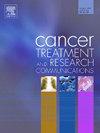USP6NL和MSX2作为胃癌患者新的诊断标志物
IF 2.4
Q3 Medicine
引用次数: 0
摘要
胃癌是世界上最常见的胃肠道恶性肿瘤之一。WNT信号通路在胃癌的发生和发展中起关键作用。USP6NL属于GAP蛋白家族,在肿瘤进展过程中通过β-catenin稳定化调节WNT信号。因此,在本研究中,我们首次在胃癌患者中检测了USP6NL通过调节WNT信号通路在肿瘤进展中的作用。C-MYC和MSX2在GC患者中作为WNT靶基因进行评估,以评估USP6NL通过WNT调控在GC进展中的作用。采用Real - time聚合酶链反应(Real - time polymerase chain reaction)检测83例新鲜肿瘤和相应的正常组织中USP6NL、MSX2和C-MYC mRNA的表达水平。非贲门肿瘤中USP6NL水平明显高于贲门肿瘤(p = 0.03)。USP6NL在女性非贲门肿瘤中的表达水平也明显高于男性(p = 0.032)。MSX2上调的低级别肿瘤与低生存率显著相关(p = 0.012)。MSX2上调与女性GC患者较低的生存率显著相关(p = 0.041)。USP6NL水平与MSX2水平(p≤0.0001)和C-MYC水平(p = 0.001)也有显著相关。USP6NL/MSX2/C-MYC轴可作为GC的可靠诊断标记或治疗靶点,通过进一步的体外和动物实验。本文章由计算机程序翻译,如有差异,请以英文原文为准。
USP6NL and MSX2 as the novel diagnostic markers in gastric cancer patients
Gastric cancer (GC) is one of the most frequent gastrointestinal malignancies in the world. WNT signaling pathway has a key role in the occurrence and progression of GC. USP6NL belongs to the GAP protein family that regulates the WNT signaling by the β-catenin stabilization during tumor progression. Therefore, for the first time in the present study, we examined the role of USP6NL in tumor progression through the regulation of WNT signaling pathway among GC patients. C-MYC and MSX2 were also assessed in GC patients as the WNT target genes to evaluate the role of USP6NL during GC progression via WNT regulation. Eighty-three freshly tumor and corresponding normal tissues were enrolled to assess the levels of USP6NL, MSX2, and C-MYC mRNA expressions using the Real time polymerase chain reaction. There was significant higher levels of USP6NL in non-cardia compared with cardia tumors (p = 0.03). There was also significant higher levels of USP6NL expressions in non-cardia tumors of females compared with males (p = 0.032). Low-grade tumors with MSX2 up regulation were significantly associated with low survival (p = 0.012). MSX2 up regulation was significantly correlated with lower survival among the female GC patients (p = 0.041). The levels of USP6NL was also significantly correlated with the levels of MSX2 (p ≤ 0.0001) and C-MYC (p = 0.001). USP6NL/MSX2/C-MYC axis can be introduced as a reliable diagnostic marker or therapeutic target in GC following the further in-vitro and animal studies.
求助全文
通过发布文献求助,成功后即可免费获取论文全文。
去求助
来源期刊

Cancer treatment and research communications
Medicine-Oncology
CiteScore
4.30
自引率
0.00%
发文量
148
审稿时长
56 days
期刊介绍:
Cancer Treatment and Research Communications is an international peer-reviewed publication dedicated to providing comprehensive basic, translational, and clinical oncology research. The journal is devoted to articles on detection, diagnosis, prevention, policy, and treatment of cancer and provides a global forum for the nurturing and development of future generations of oncology scientists. Cancer Treatment and Research Communications publishes comprehensive reviews and original studies describing various aspects of basic through clinical research of all tumor types. The journal also accepts clinical studies in oncology, with an emphasis on prospective early phase clinical trials. Specific areas of interest include basic, translational, and clinical research and mechanistic approaches; cancer biology; molecular carcinogenesis; genetics and genomics; stem cell and developmental biology; immunology; molecular and cellular oncology; systems biology; drug sensitivity and resistance; gene and antisense therapy; pathology, markers, and prognostic indicators; chemoprevention strategies; multimodality therapy; cancer policy; and integration of various approaches. Our mission is to be the premier source of relevant information through promoting excellence in research and facilitating the timely translation of that science to health care and clinical practice.
 求助内容:
求助内容: 应助结果提醒方式:
应助结果提醒方式:


